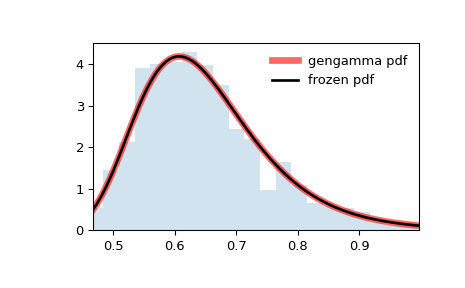scipy.stats.gengamma#
- scipy.stats.gengamma = <scipy.stats._continuous_distns.gengamma_gen object>[source]#
广义伽马连续随机变量。
作为
rv_continuous类的实例,gengamma对象继承了它的一组通用方法(详见下面的完整列表),并使用此特定分布的详细信息完成它们。方法
rvs(a, c, loc=0, scale=1, size=1, random_state=None)
随机变量。
pdf(x, a, c, loc=0, scale=1)
概率密度函数。
logpdf(x, a, c, loc=0, scale=1)
概率密度函数的对数。
cdf(x, a, c, loc=0, scale=1)
累积分布函数。
logcdf(x, a, c, loc=0, scale=1)
累积分布函数的对数。
sf(x, a, c, loc=0, scale=1)
生存函数(也定义为
1 - cdf,但 sf 有时更准确)。logsf(x, a, c, loc=0, scale=1)
生存函数的对数。
ppf(q, a, c, loc=0, scale=1)
百分点函数(
cdf的逆函数——百分位数)。isf(q, a, c, loc=0, scale=1)
逆生存函数(
sf的逆函数)。moment(order, a, c, loc=0, scale=1)
指定阶数的非中心矩。
stats(a, c, loc=0, scale=1, moments=’mv’)
均值(‘m’),方差(‘v’),偏度(‘s’)和/或峰度(‘k’)。
entropy(a, c, loc=0, scale=1)
RV 的(微分)熵。
fit(data)
通用数据的参数估计。 有关关键字参数的详细文档,请参见 scipy.stats.rv_continuous.fit。
expect(func, args=(a, c), loc=0, scale=1, lb=None, ub=None, conditional=False, **kwds)
函数(一个参数)关于分布的期望值。
median(a, c, loc=0, scale=1)
分布的中位数。
mean(a, c, loc=0, scale=1)
分布的均值。
var(a, c, loc=0, scale=1)
分布的方差。
std(a, c, loc=0, scale=1)
分布的标准差。
interval(confidence, a, c, loc=0, scale=1)
中位数周围具有相等面积的置信区间。
另请参见
注释
\[f(x, a, c) = \frac{|c| x^{c a-1} \exp(-x^c)}{\Gamma(a)}\]对于 \(x \ge 0\), \(a > 0\), 并且 \(c \ne 0\)。 \(\Gamma\) 是伽马函数 (
scipy.special.gamma)。gengamma接受 \(a\) 和 \(c\) 作为形状参数。上面的概率密度以“标准化”形式定义。 要移动和/或缩放分布,请使用
loc和scale参数。 具体来说,gengamma.pdf(x, a, c, loc, scale)与gengamma.pdf(y, a, c) / scale完全等效,其中y = (x - loc) / scale。 请注意,移动分布的位置不会使其成为“非中心”分布; 一些分布的非中心推广版本在单独的类中提供。参考文献
[1]E.W. Stacy, “Gamma Distribution 的泛化”, Annals of Mathematical Statistics, Vol 33(3), pp. 1187–1192.
示例
>>> import numpy as np >>> from scipy.stats import gengamma >>> import matplotlib.pyplot as plt >>> fig, ax = plt.subplots(1, 1)
获取支持
>>> a, c = 4.42, -3.12 >>> lb, ub = gengamma.support(a, c)
计算前四个矩
>>> mean, var, skew, kurt = gengamma.stats(a, c, moments='mvsk')
显示概率密度函数 (
pdf)>>> x = np.linspace(gengamma.ppf(0.01, a, c), ... gengamma.ppf(0.99, a, c), 100) >>> ax.plot(x, gengamma.pdf(x, a, c), ... 'r-', lw=5, alpha=0.6, label='gengamma pdf')
或者,可以调用分布对象(作为函数)来固定形状、位置和比例参数。 这将返回一个“冻结”的 RV 对象,该对象保存给定的固定参数。
冻结分布并显示冻结的
pdf>>> rv = gengamma(a, c) >>> ax.plot(x, rv.pdf(x), 'k-', lw=2, label='frozen pdf')
检查
cdf和ppf的准确性>>> vals = gengamma.ppf([0.001, 0.5, 0.999], a, c) >>> np.allclose([0.001, 0.5, 0.999], gengamma.cdf(vals, a, c)) True
生成随机数
>>> r = gengamma.rvs(a, c, size=1000)
并比较直方图
>>> ax.hist(r, density=True, bins='auto', histtype='stepfilled', alpha=0.2) >>> ax.set_xlim([x[0], x[-1]]) >>> ax.legend(loc='best', frameon=False) >>> plt.show()
